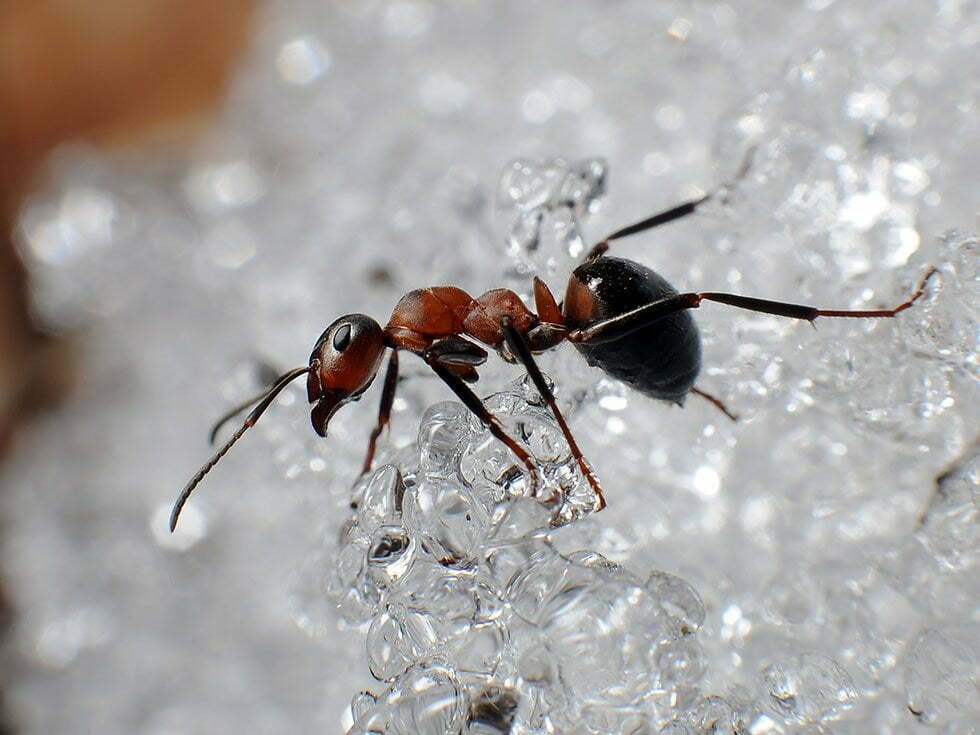The snow melts with the warming weather, and as you start spring cleaning, you come across large black ants. Sound familiar? These could be ants (possibly carpenter ants) just waking up from their winter slumber! But why have they made it all the way into your house? Is their presence a sign of a more serious problem?
If you see ants in your home in spring, don’t hesitate to contact an ant exterminator to get an accurate picture of the situation.
The different habits of ants through the seasons
The degree of activity and the habits of ants vary with each season. They adopt different behaviours in order to adapt to environmental changes and guarantee the survival of their colony.
Therefore, the presence of these insects in the house can mean different things depending on the season and the ant species you have seen.
The behaviour of ants in summer and fall
During summer and fall, ants are usually very active outdoors. They spend their time looking for food to feed their colony. They may, on occasion, infiltrate a building to find crumbs to carry back to the nest.
So, seeing a few ants in the house in summer doesn’t automatically mean that a colony is growing indoors. These ants might just simply be passing through.
Winter: Ants enter diapause
Over the winter, ants go into a “hibernation” period. This “hibernation” is more accurately called diapause. During this period, their metabolism is reduced to its lowest point in order to preserve energy. As a result, this period is also characterized by diminished activity of the colony and its queen.
Seeing ants in your home in winter during this period of diapause is a classic sign that there is probably a nest in your residence or located very near to the foundations, as their activity should normally be minimal. In very mild weather, they may awaken and start looking for food in the house. You’ll also notice the ants appear to be moving slowly.
How ants wake up in spring
As soon as temperatures are mild enough, the ants wake from diapause and begin to search for food and water. You might see a few of them in the kitchen or washroom. In the springtime, it is more common to see large black ants.
Where do ants hide in the winter and spring?
Ants generally “hibernate” in underground nests or inside a cavity. They hide there all winter until temperatures rise. They will leave their hiding place when all the snow will have melted and the ground will have thawed.
Some species of ants are able to build their nest inside a house. This is true of carpenter ants that chew out galleries of tunnels inside structural timber. These ants could then spend the whole winter indoors and grow their colony from year to year if you do not intervene with an adequate strategy.
What does it mean if I see large ants in the house early in springtime?
Some homeowners may see large black ants in the house very early in spring, when the ground is still partially frozen and the snow has not all melted away. This might occur as early as the beginning of March, and these ants often turn out to be carpenter ants. Smaller ants, such as pavement ants, appear later in May or June.
The presence of black ants in the house at this particular time of the year means that a nest is established in a location that warms up quickly in spring (indoors, near the foundations, etc.). As soon as temperature become milder – even if they remain below the freezing point – the ants already inside the house will become active earlier and begin looking for food, while outdoors not a single sign of their presence will be observed!
Signs of an ant problem in spring
Here are a few signs that might confirm the ants you saw weren’t just passing through:
- You see winged ants emerging from wall fissures. Carpenter ants produce winged ants in the fall and keep them inside the colony over the winter. Come spring time, these winged ants leave the colony for mating season. Seeing winged ants indoors is a sure sign that a colony of ants is indeed installed in your home.
- You see great numbers of ants in the house, or very regularly.
- You find ants on the second floor of the house (in the washroom, for example).
- You find sawdust near the frames of windows, doors, and wall.
- You hear noises inside the walls. These noises may be very faint, but when there are large numbers of carpenter ants, it is possible to hear cracking noises in the walls and ceilings when the house is quiet. You must listen very attentively!
- You see ants indoors before you see ants outdoors.
- The ants you see are large and black (carpenter ants).
What should I do if the ants are present only in spring?
If you see ants only in springtime and there doesn’t seem to be any ants during the rest of the year, we still advise that one of our technicians be called to inspect your home.
As explained above, the ants are probably more present in spring because they’re actively looking for food. In summer, the ants are active mostly outdoors. Seeing ants in spring every year may signal a problem which could grow in proportion over the years.
In case of doubt, it is best to contact an ant extermination specialist like Avalanche Extermination. Carpenter ants can cause significant damage to your home. Ask for a free estimate today to get all the facts about the extent of the situation.

